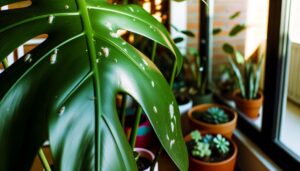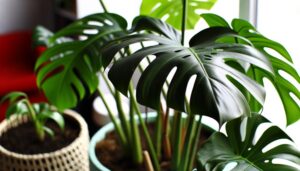Monstera Peru Humidity Needs
To maintain your Monstera Peru's flourishing, keep humidity levels between 60% and 80%. This range supports peak photosynthesis and transpiration, thanks to efficient stomatal function.
Signs of low humidity include leaf curl, brown edges, and stunted growth, typically below 50%. Excess humidity, above 90%, can cause fungal infections and root rot.
Employ methods like misting, humidifiers, or pebble trays to sustain the ideal environment. Use a hygrometer for precise monitoring, avoiding direct sunlight or airflow.
Learn how to manage atmospheric moisture better to prevent common issues and optimize plant health.

Key Takeaways
- Monstera Peru thrives in humidity levels between 60% and 80%.
- Low humidity causes leaf curl, brown edges, and stunted growth.
- Excessive humidity above 90% can lead to fungal infections and root rot.
- Use hygrometers to accurately monitor and maintain ideal humidity levels.
- Methods to increase humidity include misting, pebble trays, and humidifiers.
Importance of Humidity
Sustaining ideal moisture levels is crucial for the physiological processes and overall health of Monstera Peru. You'll notice that relative moisture levels between 60% and 80% are best for this plant's photosynthesis and transpiration.
High moisture assists in stomatal function, guaranteeing efficient gas exchange and moisture regulation. When moisture drops below 50%, you may notice leaf curl, brown edges, and stunted growth.
Conversely, excessively high moisture, above 90%, can promote fungal infections and root rot. Monitoring tools, such as hygrometers, help uphold consistent moisture levels. Integrating a humidifier or a pebble tray can help you achieve and sustain the needed moisture.
Comprehending and controlling moisture guarantees that Monstera Peru remains vibrant and physiologically balanced.
Native Habitat Conditions
In its native habitat, Monstera Peru thrives in the humid, tropical rainforests of Central and South America, where the environment provides consistent humidity and filtered light. These rainforests offer ideal conditions for this epiphytic plant. You'll find Monstera Peru clinging to tree trunks, absorbing moisture from the air through aerial roots.
Key conditions include:
- High Humidity: Rainforests maintain humidity levels typically above 70%, essential for Monstera Peru's growth.
- Filtered Light: The dense canopy filters sunlight, preventing direct exposure while allowing sufficient light for photosynthesis.
- Moist Substrate: The forest floor and tree bark retain moisture, aiding in water absorption.
- Warm Temperatures: Consistently warm temperatures ranging from 65°F to 85°F support metabolic processes.
Understanding these conditions helps replicate them for indoor cultivation.
Humidity Levels Explained
You need to maintain an ideal humidity range of 60-80% for Monstera Peru to thrive.
If humidity levels drop, you might observe leaf curling, browning edges, and stunted growth—clear indicators of low humidity stress.
To effectively increase humidity, you can use methods such as misting, humidifiers, or pebble trays.
Optimal Humidity Range
Monstera Peru thrives best in an environment with humidity levels ranging between 60% to 80%, as these conditions mimic its native tropical habitat and support ideal physiological processes. Maintaining this peak humidity range enhances the plant's transpiration rate, photosynthetic efficiency, and nutrient uptake.
You should monitor and adjust humidity to guarantee your Monstera Peru remains healthy and vibrant. Consider these methods for maintaining the appropriate humidity levels:
- Use a humidifier: This device can help you maintain consistent humidity.
- Group plants together: This raises the local humidity through collective transpiration.
- Place a humidity tray: Fill a tray with water and pebbles, placing the pot atop.
- Mist regularly: Lightly misting the leaves increases local humidity temporarily.
Implementing these strategies will optimize growth conditions effectively.
Signs of Low Humidity
When humidity levels drop below the ideal range, your Monstera Peru exhibits symptoms such as browning leaf edges, reduced growth rate, and increased susceptibility to pests. You'll notice leaf margins turning dry and crispy, which indicates desiccation due to insufficient ambient moisture. Additionally, the plant's overall vigor declines as stunted growth becomes evident. Low humidity also creates a favorable environment for spider mites and other pests, exacerbating stress on the Monstera Peru.
| Symptom | Description | Cause |
|---|---|---|
| Browning Leaf Edges | Dry, crispy leaf margins | Desiccation from low ambient moisture |
| Reduced Growth Rate | Stunted, slow growth | Insufficient humidity affecting metabolism |
| Increased Pest Susceptibility | Infestations of spider mites, etc. | Favorable low-humidity conditions |
These signs are clear indicators that your plant's environment needs adjustment.
Increasing Humidity Levels
Boosting humidity levels around your Monstera Peru involves employing techniques such as pebble trays, misting, and utilizing humidifiers to create a more suitable microclimate. Elevated humidity is essential for mimicking the plant's native tropical environment, thereby facilitating ideal physiological processes like transpiration and photosynthesis.
To increase ambient moisture effectively, consider the following methods:
- Pebble Trays: Position the plant pot on a tray filled with water and pebbles to enhance localized humidity without waterlogging the roots.
- Misting: Regularly spray the foliage with distilled water to prevent mineral build-up and simulate natural humidity.
- Humidifiers: Use a humidifier to maintain consistent humidity levels, ideally between 60-80%.
- Grouping Plants: Cluster your Monstera with other plants to create a micro-humid environment through collective transpiration.
Signs of Low Humidity
Indicators of low humidity in Monstera Peru include curling leaves, brown leaf edges, and stunted growth due to insufficient moisture levels in the air.
When relative humidity drops below 40%, the plant's stomata close to conserve water, reducing photosynthesis efficiency. This physiological response results in leaf curling as turgor pressure decreases.
Brown leaf edges are symptomatic of desiccation, where leaf tissues lose moisture faster than it's replenished.
Stunted growth occurs because cellular processes, like mitosis and nutrient transport, slow down under low humidity.
You might also notice increased susceptibility to pests such as spider mites, which thrive in dry conditions.
Monitoring a hygrometer can help you maintain optimal humidity levels, ensuring your Monstera Peru remains healthy and vibrant.
Signs of High Humidity
Excessive humidity levels can lead to issues like fungal growth, yellowing leaves, and edema in your Monstera Peru. When the air moisture is too high, you might notice the following signs:
- Fungal Growth: Observe for powdery mildew or black spots on the leaves, indicating fungal proliferation due to excess moisture.
- Yellowing Leaves: High humidity can cause chlorosis, leading to yellow, discolored leaves as the plant struggles to manage water uptake.
- Edema: Look for water-soaked patches or blister-like formations on the leaves, a result of cells bursting from over-absorption of water.
- Leaf Drop: Excess moisture can stress the plant, leading to premature leaf drop as it attempts to reduce transpiration.
Monitoring these signs helps maintain ideal conditions for your Monstera Peru.
Measuring Humidity
To measure humidity accurately, you'll need to use a hygrometer, which quantifies the moisture content in the air.
Regularly calibrate your hygrometer to maintain precision.
Aim for ideal humidity levels between 60-70% for your Monstera Peru to thrive.
Using Hygrometers Effectively
Accurately measuring the humidity levels for your Monstera Peru is essential, and using a hygrometer allows you to monitor these levels with precision.
When utilizing a hygrometer, follow these steps for best accuracy:
- Calibration: Regularly calibrate your hygrometer according to the manufacturer's guidelines to maintain precise readings.
- Placement: Position the hygrometer near your Monstera Peru, avoiding direct sunlight or drafts, to obtain consistent measurements reflective of the plant's microenvironment.
- Recording: Log humidity levels at different times of the day to understand fluctuations and identify patterns.
- Maintenance: Clean the hygrometer's sensor periodically to prevent dust and debris from affecting its sensitivity.
Optimal Humidity Levels
Maintaining a humidity level between 60% and 80% is crucial for the top growth and health of your Monstera Peru. To measure humidity accurately, you should use a calibrated hygrometer. Place the hygrometer near the plant, ensuring it's not in direct sunlight or airflow, as these factors can skew readings. Observe the digital display for real-time data.
Ideally, readings should stay in the 60-80% range consistently. If levels drop, consider using a humidifier or a humidity tray. High humidity levels promote best photosynthesis and transpiration processes, enhancing leaf vitality and growth. Regularly monitor and adjust as needed to maintain these conditions, ensuring your Monstera Peru thrives in a stable, humid environment.
Increasing Humidity
When aiming to increase humidity for your Monstera Peru, utilizing a humidifier can greatly enhance moisture levels, fostering ideal growth conditions. However, there are additional strategies you can employ to optimize humidification:
- Grouping Plants: Placing multiple plants together creates a microenvironment with higher humidity due to collective transpiration.
- Pebble Trays: Fill a tray with water and pebbles, placing your plant pot on top. This promotes gradual evaporation and increased humidity around the plant.
- Misting Leaves: Regularly misting the leaves with distilled water can temporarily elevate local humidity levels.
- Room Placement: Positioning your Monstera Peru in naturally humid areas like bathrooms or kitchens can capitalize on ambient moisture.
Using Humidifiers
When choosing a humidifier for your Monstera Peru, prioritize models with adjustable humidity settings to maintain ideal moisture levels.
Position the humidifier near the plant but avoid direct misting to prevent fungal growth.
Monitor the ambient humidity with a hygrometer to guarantee consistency and promote healthy foliage development.
Choosing the Right Humidifier
Selecting the best humidifier for your Monstera Peru involves evaluating factors like output capacity, mist type, and ease of maintenance to guarantee consistent humidity levels. You need to take into account several technical specifications for the best performance.
- Output Capacity: Make sure the humidifier can maintain 60-70% humidity, the ideal range for Monstera Peru.
- Mist Type: Ultrasonic or cool-mist models are preferred for their efficiency and safety.
- Tank Size: Larger water tanks reduce the frequency of refilling, enhancing convenience.
- Maintenance: Choose models with easy-to-clean components to prevent mold and bacterial growth.
Placement for Optimal Growth
Positioning your humidifier correctly is essential to guaranteeing your Monstera Peru receives the best humidity levels for healthy growth. Place the humidifier about 3-5 feet from the plant to create a microenvironment with peak humidity.
Avoid direct streams of mist hitting the foliage, which can cause waterlogging and fungal issues. Measure the ambient humidity using a hygrometer, aiming for levels between 60-70%.
Guarantee the humidifier runs continuously during dry periods, especially in winter when indoor air is dry. Position it in a well-ventilated area to prevent mold buildup.
Regularly clean the humidifier to eliminate mineral deposits and microbial contamination, maintaining ideal conditions for your Monstera Peru's peak growth.
DIY Humidity Solutions
To maintain ideal humidity levels for your Monstera Peru, consider using a pebble tray, which increases ambient moisture through evaporation. Place a shallow tray filled with pebbles and water beneath the plant. As the water evaporates, it elevates the localized humidity.
For the best possible outcomes, integrate these DIY solutions:
- Humidity Tray: Utilize a pebble tray, ensuring water level remains below the pebble tops to prevent root rot.
- Mist Spraying: Regularly mist the leaves with distilled water to provide micro-environmental humidity.
- Grouping Plants: Cluster your Monstera with other plants to create a micro-humid environment through collective transpiration.
- Humidifier: Deploy a humidifier near the plant to maintain consistent humidity levels, ideally between 60-80%.
These methods collectively enhance the hygroscopic conditions essential for Monstera Peru's health.
Seasonal Humidity Changes
Monitoring seasonal moisture changes is crucial for maintaining ideal conditions for your Monstera Peru.
In winter, indoor heating systems can significantly decrease relative humidity, often dropping it below the optimal 60-80% range. You'll notice drier air causing leaf edges to brown and curl. Use a hygrometer to measure indoor humidity accurately. Implement humidifiers or misting systems to counteract dry winter air.
Conversely, during summer, increased ambient humidity might require adjustments to prevent fungal growth on leaves and roots. In summer, improve air circulation using fans or dehumidifiers if necessary. Always monitor humidity levels closely, as fluctuations outside the ideal range impact photosynthesis and transpiration rates, affecting overall plant health.
Keeping consistent moisture levels ensures your Monstera Peru thrives year-round.
Long-Term Care Tips
Maintaining ideal humidity is just one aspect of long-term care for your Monstera Peru, which also involves proper light exposure, soil composition, and nutrient management.
You should make sure that your plant receives bright, indirect light to mimic its natural habitat.
A well-draining soil mix, rich in organic matter, is essential for preventing root rot and promoting healthy growth.
Regular feeding with a balanced, water-soluble fertilizer will support its nutritional needs.
To further optimize care, consider the following:
- Repot every 2-3 years to refresh the soil and provide space for root expansion.
- Prune regularly to remove dead or yellowing leaves, encouraging new growth.
- Monitor for pests like spider mites and scale insects, using neem oil if necessary.
- Maintain consistent watering to keep the soil moist but not waterlogged.
Conclusion
To keep your Monstera Peru thriving, you need to monitor humidity levels, adjust conditions as needed, and use tools like humidifiers.
Recognize signs of low humidity, such as browning leaves, and signs of high humidity, such as mold.
Embrace DIY solutions like pebble trays and misting.
Understand seasonal changes and adapt your care routine accordingly.
By ensuring ideal humidity, you'll foster healthy growth, vibrant leaves, and a stunning Monstera Peru that enhances your indoor environment.






